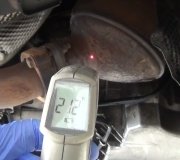Depends on how it was wired. This was GM's first attempt at electronic ignition. It was a nice system, but it was designed to be repaired by replacing the entire distributor. Mechanics of that era had a hard time understanding alternators and electronic ignition systems, (both Chrysler innovations). Today we realize these were real simple once they were understood. GM likes to build their cars with large assemblies. They go together quickly on the assembly line, but owners have to buy the whole unit to get the one part they need.
That is an advantage in your case because the entire modification involves dropping in the distributor and connecting one 12 volt feed wire. The entire ignition system, except for the spark plugs and wires, is built into the assembly. Where you might run into trouble is the points system had a ballast resistor in series with the ignition coil. That must be eliminated if you use that wire to feed the HEI distributor. To add to the confusion, that resistor could be a resistor wire hidden in the wiring harness.
The way to tell if you have a resistor in the harness is to disconnect that twelve volt feed wire from the distributor, turn the ignition switch on, then measure the voltage on that wire. You will find full battery voltage. For this sad story, we will say that is 12.6 volts. Now also connect a test light alongside the voltmeter and see what the meter reads. If there is a resistor in the harness, the current flow going to the test light will cause some voltage to be dropped across it, so what you see with the meter will drop a little. That might only be a few tenths of a volt. To be really sure, use some small jumper wires to connect a head light bulb to that wire. Those draw about five amps. That much current will cause a very large voltage drop across a resistor wire and the bulb will not be very bright.
If the voltage stays the same when you connect the test light or the head light bulb, there is no resistor that needs to be removed.
The first version of this system had the normal mechanical and vacuum advance built in like all other distributors had at that time. There was some confusion as to where the vacuum advance hose was supposed to be connected at the carburetor. Most systems put that hose on a port above the throttle blade. That way vacuum advance builds up at higher road speeds when the throttle is open and the blade goes above the port. Vacuum advance provides better fuel mileage by igniting the mixture sooner. Since it takes some time for the gas to burn, it needs to start that burn sooner at higher engine speeds. This system has no vacuum during cranking which makes for easier cranking. Timing is set with the vacuum hose disconnected at the distributor, and plugged.
There were some systems that put the vacuum hose below the throttle blade, or even on a tap screwed into the intake manifold. There still is no vacuum during cranking, so the engine should spin easily, but that vacuum showed up as soon as the engine started running. The thinking was base timing was with vacuum applied, and that is how it is adjusted, then that vacuum advance was lost during acceleration to reduce spark knock. From what I can remember, it seems to me this system was responsible for a lot of real slow, hard cranking when the engine was hot. You would need to find a vacuum hose routing diagram for a car this distributor came from to know for sure how to connect the hose.
Other than checking for full system voltage feeding the distributor, and correct vacuum hose routing, this is just a different way of generating the spark. Stumbles, hesitation, and low power are diagnosed the same way you would with any other engine.
"Acceleration problems" does not say what problem you are having. If you have a Quadrajet carburetor, check for proper operation of the accelerator pump. If you do not have a vacuum advance unit on the distributor, you have one meant to be used with an engine computer. That distributor still generates the timing signal, and its internal module still fires the ignition coil, but that timing signal is seriously-advanced. The computer calculates the mount of delay it wants before telling the module to fire the coil. That is how it adjusts spark timing.
Wednesday, January 10th, 2018 AT 8:25 PM


